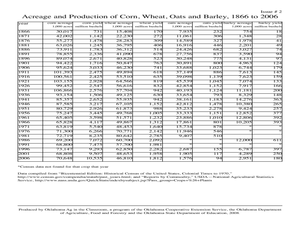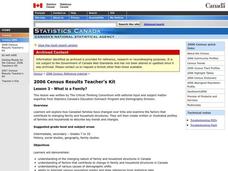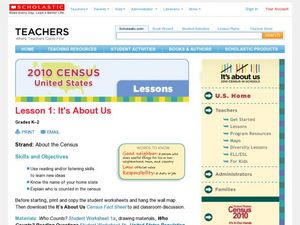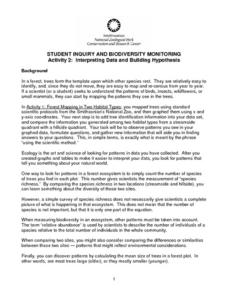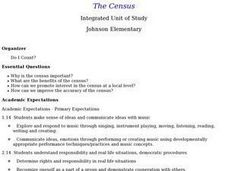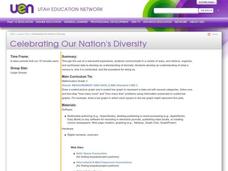Curated OER
Create a City: An Urban Planning Exercise
Students explore the effects of population growth in Arizona. In this history lesson, students work in small groups to create a "perfect" city. Activities include examining the Arizona census results then discussing the importance...
Curated OER
George Washington and the First Census of Agriculture
Sixth graders compare modern agricultural statistics with those that are extracted from a primary source letter of George Washington. They complete worksheets and discuss what they have learned.
Curated OER
An Aging Population - Economic Problem or Opportunity
Students explore if the aging population has any effect on the economy and overall well-being of society. In this economic lesson, students research the economic impact of the older citizens. They develop their own ideas and...
Curated OER
Important Decisions Don't Just Happen! Using Data to Plan Your Services
Students interpret statistics. In this data lesson, students examine and organize given data. They present the data in a grid format. Using the census data, students determine the best location for a local business.
Curated OER
What is a Family?
Students explore how Canadian families have evolved over time. In this census results lesson, students examine the factors that contribute to changing family and household structures. Students also create written and illustrated profiles...
Curated OER
Classroom Census (Analyzing Data)
Young scholars create graphs. For this data analysis lesson, students fill out a student census and then use the data collected to produce graphs. Young scholars write paragraphs interpreting the data.
Curated OER
Canadian Immigration
Students discover where Canadian immigrants have come from and their contribution to the country. In this cultural instructional activity, students use a map to indicate the native homes of immigrants, and create a paper chain to...
Curated OER
A Class Census
Students recognize that data represents specific pieces of information about real-world activities, such as the census. In this census lesson, students take a class and school-wide census and construct tally charts and bar graphs to...
Curated OER
Why We Count
Students visualize census data on a map and use a map key to read a population map. In this census lesson, students use a map of the Virgin Islands and corresponding worksheets to gain an understanding of population density.
Curated OER
2010 Census Lesson 1: It's About Us
Students analyze data from the 2000 census to learn how the census works. In this civics lesson, students read a story to find out about the census, then use a map and census data to analyze changes. Lesson includes related resources...
Curated OER
It's About Us
Students understand ideas about civic life and government. For this census lesson, students participate in a First We Count Reader's Theater and answer reading questions about the script in order to gain a better understanding of the...
Curated OER
Then and Now
Students conduct research and use census data to compare different times and places. In this census lesson, students interpret data from charts and graphs, comparing census information from two time periods as well as from two different...
Curated OER
About the Census
Students interpret a variety of informational texts to gain understanding of basic concepts about how census data are used. In this census lesson, students read maps, complete worksheets, and work in small groups to become aware of...
Curated OER
Then and Now
Students explore population and come to understand how it changes over time. In this census lesson, students discover what population is and how it changes as they participate in age-appropriate activities.
Curated OER
Mapping Our Home
Students explore how communities participate in census counting. In this census lesson, students recognize the absolute and relative location of a state and understand ideas about civic life and government.
Curated OER
Interpreting Data and Building Hypothesis
Students define the term species, and graph species data together with previously collected data at the National Zoo. They interpret graphed data and recognize patterns in the streamside quadrant versus hillside quadrant. Students use...
Curated OER
You Be The Census Taker
Learners interpret information from an excerpt of the 1870 U.S. Census and compare that data to economic data they collect about local businesses in their own community. Students then evaluate how closely linked their community's economy...
Curated OER
The Census
Young scholars analyze why the census is important and the benefits of it. Determine rights and responsibilities in real life situations. They are divided into groups and take a mock census of a list of teachers and students each....
Curated OER
By Any Other Name
Students examine the differences between the definitions of race and ethnicity defined by the United States government. After reading an article, they discuss the possiblity of the elimination of some races from the 2010 census. They...
Curated OER
The Demographics of Immigration: Using United States Census Data
Learners work together to analyze United States Census data on immigration. They compare and contrast the data and determine how immigration numbers have changed over time. They calculate percentages and make their own conclusions...
Curated OER
Time Changes Everything
Students analyze census data from 1915, 1967 and 2006. They read an article about how the world's population is growing at an alarming rate. They use primary source documents to create a timeline on the information they gathered. They...
Curated OER
Create Your Own Form
Students gather and organize data using a mock census form, and determine mean, mode, range, and median for sets of data.
Curated OER
Celebrating Our Nation's Diversity
Second graders conduct a class census to measure diversity.
Curated OER
Census and Gold Rush Town
Students analyze data and form a mental picture of the make up of a gold rush town. They explain social life in a gold rush town. They use online sources to see paintings of camp life and read accounts of miners' lives.



